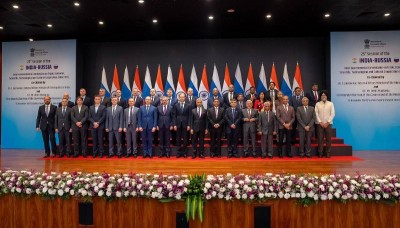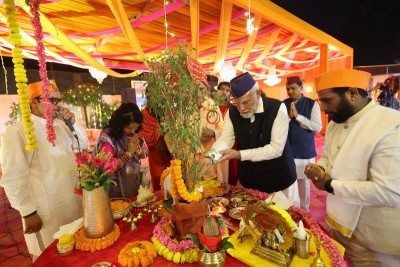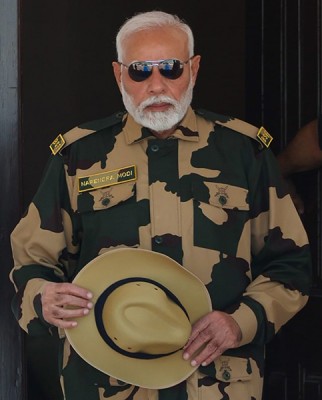
Punjab: Creeping Shadow of Daesh
On November 25, 2015, Lashkar-e-Jhangvi (LeJ) founder Haroon Bhatti and three of his accomplices were killed in a midnightraid jointly conducted by the Counter-Terrorism Department (CTD) and Police in the Badami Bagh area of the provincial capital, Lahore. Bhatti's slain accomplices were identified as, Omair Nadeem, Omair Hassan and Noman Yasin. Three Policemen were also injured in the gunfight. On October 22, 2015, the Police had brought Bhatti and four of his associates back to Pakistan, from Dubai, with the help of Interpol. According to official sources, Bhatti was accompanying the Police and CTD personnel to an abandoned factory where LeJ terrorists were hiding. On reaching the location, the terrorists hiding inside the factory allegedly opened fire, killing Bhatti and the three others. Later, an unnamed senior Police official admitted that the killings were staged by the authorities. In an interview toThe Guardian a Lahore-based Police official, on condition of anonymity, admitted,
This had to be done to maintain peace in the Province. No one would have given evidence against them because witnesses would be brutally targeted. You can't allow terrorists to carry on their attacks just because you don't have any proof against them.
Bhatti, one of the founding members of LeJ, was accused of involvement in over two dozen terrorist attacks. Significantly, Bhatti was a close aide of former LeJ chief Malik Ishaq, who was killed in a similar exchange of fire with the Police on July 29, 2015, along with his two sons Usman and Haq Nawaz, and another 11 accomplices. The Police had then claimed that Ishaq had attempted to escape from their custody.
On November 26, 2015, SFs arrested nine LeJ terrorists from the Farooq-e-Azam Madrassa (seminary) in the Cantonment area of Lahore. According to an unnamed senior CTD official a huge quantity of hate material was recovered from the seminary which was involved in various terrorist incidents and was the last stronghold of the LeJ in Lahore. The CTD official stated that the seminary was sealed under the National Action Plan (NAP). Federal Minister of the Interior Chaudhry Nisar Ali Khan had told the National Assembly on November 11, 2015, that a total of 102 seminaries had been sealed in the country for fanning extremism since the implementation of NAP on December 24, 2014. Of these, he disclosed, 87 madrassas were closed in Sindh; 13 in Khyber Pakhtunkhwa; and two in Punjab where a number of students were found in contact with banned groups. The total number of seminaries sealed in Punjab now stands at three.
According to data compiled by the South Asia Terrorism Portal (SATP), 165 persons have been killed in terrorism related incidents in the current year in Punjab (all data till December 6, 2015). Of these 90 were civilians, 66 terrorists and nine SF personnel. In the corresponding period in 2014, a total of 171 persons had been killed, including 129 civilians, 22 terrorists and 20 SF personnel. With fatalities among civilians and SFs dropping considerably, the Province has experienced some respite from terror, even as a significant number of terrorists has been eliminated.
Data provided by the Provincial Home Department on November 24, 2015, stated that at least 48 terrorists, 17 of them 'high profile', had been killed by the CTD under NAP. An official also claimed that CTD had arrested 5,812 terrorists and their collaborators from different cities of Punjab in intelligence-based operations, averting major acts of terrorism. Of them, 1,265 were arrested in Bahawalpur District, 1,040 in Gujranwala District, 1,008 in Rawalpindi District, 810 in Sargodha District and 233 in Lahore District.
Law enforcement agencies have succeeded to some degree in minimizing the threats from domestically oriented terror outfits such as LeJ and the Tehreek-e-Taliban Pakistan (TTP), but the emergence of Islamic State (IS, also known as Daesh) has introduced new complexities in the profile of terrorism in Punjab. Daesh is looking to expand its jihad by seeking allegiance from domestically oriented outfits like TTP, Jundullah, and others, who are currently under pressure from the Pakistani security establishment, and has launched a sustained and intensive campaign through the Internet. The campaign is securing particular resonance among increasingly disoriented domestic formations, which have suffered mounting losses over the past year. Specifically, since the launch of Operation Zarb-e-Azb in the North Waziristan Agency of the Federally Administered Tribal Areas (FATA) on June 15, 2014, Pakistani SFs have killed at least 4,481 terrorists, almost all of them belonging to domestically oriented terror formations.
Notably, on July 6, 2014, a lesser known Punjab-based terror outfit, Tehreek-e-Khilafat-o-Jihad (Movement for Caliphate and Jihad), an offshoot of the TTP, had declared:
From today, Sheikh Abu Bakr al-Baghdadi shall consider Tehreek-e-Khilafat and Jihad mujahideen fighters of Pakistan as one of the arrows among his arrows which he has kept for his bow. We are praying from the almighty Allah to give us chance in our lives to see the expansion of Islamic State boundaries toward the Subcontinent and Khurasan region in order to hoist the flag of Islamic State here.
Three months after threatening "worst attacks" in Islamabad and Lahore, the then TTP 'spokesman' Shahidullah Shahid, in a 16-minute online video released on October 4, 2014, had pledged allegiance to IS, along with dozens of other terrorists. On June 15, 2014, following the launch of Operation Zarb-e-Azb, Shahidullah Shahid had threatened the political elites of Punjab with "retaliatory activities by Mujahideen". Hardening in his resolve against the Punjab establishment and subsequently "extending full support" to the IS, Shahid, in his October 4, 2014 message to Daesh had proclaimed,
Oh our brothers we are proud of you in your victories. We are with you in your happiness and your sorrow. In these troubled days, we call for your patience and stability, especially now that all your enemies are united against you. Please put all your rivalries behind you. All Muslims in the world have great expectations from you.we are with you; we will provide you with fighters and with every possible support.
Shahid was sacked from TTP after pledging allegiance to IS and was killed, along with five other terrorists, in a United States (US) drone strike in the Achin District of Nangarhar Province in Afghanistan on July 7, 2015. At the time of his death he had assumed the title of 'commander' of Daesh in Afghanistan. The drone strike was confirmed by Afghanistan's National Directorate of Security.
Meanwhile, the Punjab Home Department, citing Intelligence reports, on November 27, 2015, alerted Police and other agencies in the Province that Daesh had planned attacks on civil and military targets. The Punjab Government's alert mentioned that Daesh-affiliated terrorists were out to strike Army vehicles moving on the Jalalpur Jattan Road and Police patrols on the Grand Trunk Road in Gujrat District. The intelligence report also claimed that a group of five terrorists had reached Lahore, and had planned to storm private establishments. According to an unnamed intelligence official, their likely targets included minorities and foreigners. Earlier, on October 15, 2015, the Chief of Army Staff (CoAS) General Raheel Sharif, during his visit to the Royal United Services Institute in London, had declared, "Daesh is a bigger threat than al Qaeda."
Further, on August 18, 2015, posters signed by Daesh were seen on the walls of schools in the Phugla, Fazla Kachh and Barthi areas of Dera Ghazi Khan District. The posters carried messages against co-education. Earlier, on July 4, 2015, Law Enforcement Agencies had arrested three suspected terrorists affiliated with Daesh, from Lahore and had recovered laptops confirming their links with Daesh leaders, maps of sensitive buildings in Punjab and hate literature. According to Police sources, two of the suspects, identified as Asmatullah and Abdur Rehman, hailed from Afghanistan while the third, Muhammad Ibrahim, was from Pakistan's Punjab Province.
Again, on January 21, 2015, intelligence sources had confirmed the arrest of a local Daesh 'commander', identified as Yousuf al-Salafi, and two accomplices, Qari Tayyab and Dr. Fahad, involved in recruiting and sending fighters to Syria from Lahore. According an unnamed intelligence source, "al-Salafi is a Pakistani Syrian who reached Pakistan through Turkey five months ago. He crossed into Turkey from Syria and was caught there. Somehow he managed to escape and reached Pakistan to establish IS." Al-Salafi had further revealed that one of his accomplices, Tayyab, was a prayer leader in Lahore and was involved in recruiting Pakistanis and sending them to fight alongside Daesh in Syria on a charge of about USD 600 per recruit.
However, despite the acknowledgment of the Daesh presence by the CoAS, backed by various intelligence reports, Punjab Law Minister Rana Sanaullah, demonstrating the political elite's persistent state of denial, brushed off the threat alert as being "a routine matter", arguing: "There is no existence of Daesh in Pakistan, especially in Punjab. There are some troublemakers belonging to banned outfits and the Government is making efforts to eliminate these criminals". A year earlier, the Federal Minister of Interior Chaudhry Nisar Ali Khan, in a similar note, had ruled out the existence of Daesh in the country on November 10, 2014, asserting, "No organisation of this name exists in Pakistan."
The war against terrorism, domestic and international, is contingent upon political consensus, political will, and consistency of action. Unless there is a military and political consensus on the continuum of Islamist terrorist formations operating in Pakistan, including both domestically and outward oriented groupings, and the existence of, and creeping threat posed by, Daesh, gains against a limited group of terrorist outfits will easily be frittered away. Crucially, if elements within the leadership continue to ignore the warning signs, Daesh is more likely to gain a foothold and wreak havoc in the Punjab Province, and in Pakistan at large.
Support Our Journalism
We cannot do without you.. your contribution supports unbiased journalism
IBNS is not driven by any ism- not wokeism, not racism, not skewed secularism, not hyper right-wing or left liberal ideals, nor by any hardline religious beliefs or hyper nationalism. We want to serve you good old objective news, as they are. We do not judge or preach. We let people decide for themselves. We only try to present factual and well-sourced news.







